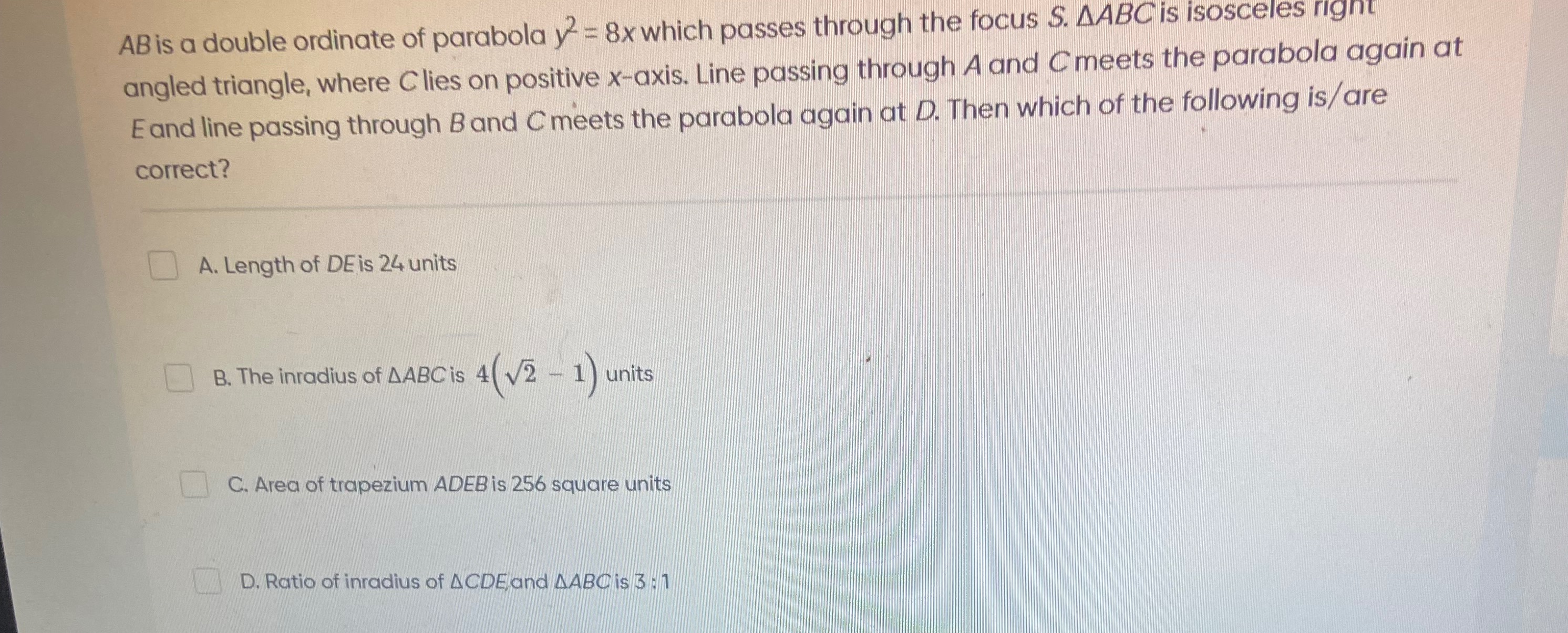Question
Question: AB is a double ordinate of parabola $y^2 = 8x$ which passes through the focus S. $\triangle ABC$ is ...
AB is a double ordinate of parabola y2=8x which passes through the focus S. △ABC is isosceles right angled triangle, where C lies on positive x-axis. Line passing through A and C meets the parabola again at E and line passing through B and C meets the parabola again at D. Then which of the following is/are correct?

Length of DE is 24 units
The inradius of △ABC is 4(2−1) units
Area of trapezium ADEB is 256 square units
Ratio of inradius of △CDE and △ABC is 3:1
A, B, C, and D
Solution
Solution:
-
Parabola and Focus: The parabola is given by
y2=8x.Writing it as y2=4ax gives a=2 so the focus is S=(2,0).
-
Double Ordinate AB: A double ordinate is a vertical chord. Since this chord passes through the focus, its line is x=2. Let the endpoints be
A=(2,y1)andB=(2,y2).They lie on the parabola so
y12=8⋅2=16andy22=16.Take A=(2,−4) and B=(2,4).
-
Triangle ABC: The vertex C lies on the positive x-axis so C=(c,0), c>0. Given that △ABC is an isosceles right triangle, we note:
CA=CB.With
CA=(c−2)2+(0+4)2=(c−2)2+16andCB=(c−2)2+(0−4)2=(c−2)2+16,the triangle is isosceles with right angle at C if
AB2=CA2+CB2.Here, AB=8 so:
64=2[(c−2)2+16]⇒(c−2)2+16=32⇒(c−2)2=16.Thus, c−2=4 (since c>0) so c=6 and C=(6,0).
-
Finding E on line AC: The line AC through A=(2,−4) and C=(6,0) has slope
m=6−20−(−4)=1.Its equation is
y=x−6.Substituting y=x−6 in the parabola:
(x−6)2=8x⇒x2−12x+36−8x=0⇒x2−20x+36=0.The solutions are
x=220±400−144=220±16.Taking x=2 (which gives A), the other intersection is x=18 so
y=18−6=12.Hence, E=(18,12).
-
Finding D on line BC: The line BC through B=(2,4) and C=(6,0) has slope
m=6−20−4=−1.Its equation is
y=−x+6.Substituting into the parabola:
(−x+6)2=8x⇒x2−12x+36−8x=0⇒x2−20x+36=0.Taking the solution x=2 gives B, the other solution is x=18 so
y=−18+6=−12.Hence, D=(18,−12).
-
Option A (Length of DE): D=(18,−12) and E=(18,12) lie vertically apart. Thus,
DE=∣12−(−12)∣=24 units. -
Option B (Inradius of △ABC): △ABC is right-angled at C with legs CA=CB. From point A to C:
CA=(6−2)2+(0−(−4))2=42+42=42.In a right triangle the inradius is
r=2a+b−c.Here, a=b=42 and the hypotenuse AB=8. So:
rABC=242+42−8=4(2−1). -
Option C (Area of Trapezium ADEB): The trapezium ADEB has vertices A=(2,−4), D=(18,−12), E=(18,12), B=(2,4). Notice that sides AD and BE are non‐parallel but the vertical sides AB (from A to B) and DE (from D to E) are parallel (both vertical).
- Length of AB: 8 units.
- Length of DE: 24 units.
- Horizontal distance between x=2 and x=18: 16 units.
So the area is
Area=21(8+24)×16=21(32×16)=256 square units. -
Option D (Ratio of inradii of △CDE and △ABC): In △CDE with vertices C=(6,0), D=(18,−12), and E=(18,12):
- CD=(18−6)2+(−12−0)2=144+144=122.
- CE=(18−6)2+(12−0)2=122.
- DE=24.
This is an isosceles right triangle (legs 122 and hypotenuse 24). Its inradius is:
rCDE=2122+122−24=2242−24=12(2−1).We have rABC=4(2−1). Therefore, the ratio is:
rABCrCDE=4(2−1)12(2−1)=3.So, the ratio is 3:1.
Final Answers:
- A. True
- B. True
- C. True
- D. True
Core Explanation: The double ordinate through the focus for y2=8x gives x=2 and points A=(2,−4) and B=(2,4). For △ABC (right angle at C on the positive x-axis) using CA=CB, we find C=(6,0). The lines AC and BC meet the parabola again at E=(18,12) and D=(18,−12) respectively. Using distance and inradius formulas for right triangles and the trapezium area formula, each option is verified.
